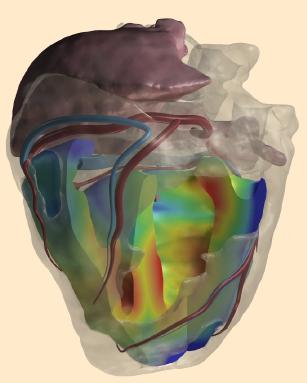Heart Model

Since the early 1980s, an electrophysiological model of the human heart is being developed at the Institute of Biomedical Engineering of the University of Montreal. We try to reproduce the surface ECG using model elements as basic as possible. The limit is determined by the available computer power. In 1982, our predecessors could model the heart with 23 dipole sources. Step by step, the models have become more realistic. In 1987, propagating action potentials were introduced. Nowadays, we compute membrane currents using a realistic model of the cell membrane and simulate propagation with a reaction-diffusion equation. From the simulated membrane potentials we compute the ECG.
bidomain
Since a few years we have a "bidomain" model of the human heart. This model simulates not only the ECG, but also cardiac electrograms, signals that can be measured inside the heart. Bidomain models are much more demanding than the older "monodomain" reaction-diffusion models, and harder to make, especially for something as large as a complete heart. These models can only work correctly with a very high spatial resolution (0.2 mm), requiring us to model the heart at about 60 million points.
resources
A bidomain model of the human heart requires about 50 GigaBytes (GB) memory, and takes 2 months of processor time to simulate one heart beat. Therefore we use supercomputers for our work. Our model usually runs on 64 processors of an SGI Altix 4700 computer at RQCHP, which does a monodomain simulation of a single heart beat in 40 minutes and a bidomain simulation in about 1 day.
the limit
In October 2007 we have successfully tested our software with a bidomain model of 2 billion (2,000,000,000) points. This is a severe test, because the program must solve a system of 2 billion linear equations for each time step. It required an entire 768-processor Altix 4700 computer, with 1.5 terabyte core memory. Such huge bidomain models may, in a few years from now, become useful to do whole-heart simulations with details as small as a single cell. This will allow a much more realistic representation of the complex structure of the cardiac muscle. For now, they are simply too expensive: with 2 billion points it would take more than 2 weeks on this multi-million dollar machine to compute a single heart beat!